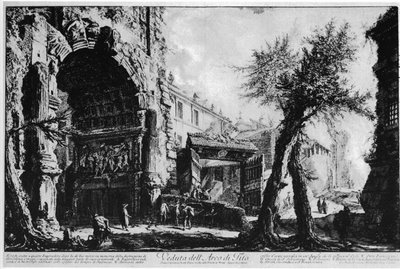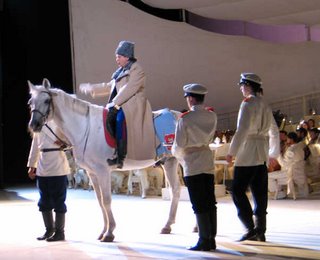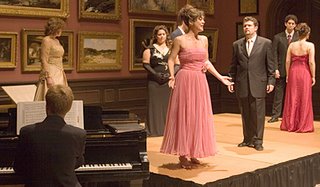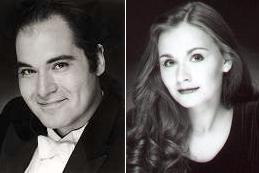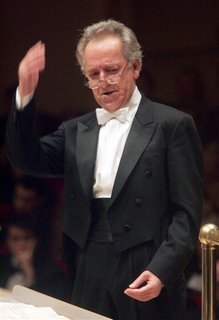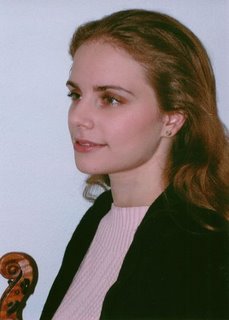Last month | Next monthClassical Month in Washington is a monthly feature that appears on the first of the month. If there are concerts you would like to see included on our schedule, send your suggestions by e-mail (ionarts at gmail dot com). Happy listening!Thursday, June 1, 7 pm; Friday, June 2, 1:30 pm; Saturday, June 3, 8 pm
National Symphony Orchestra, with Kurt Masur, guest conductor
Beethoven's Leonore Overture and Symphonies 1 and 7
Kennedy Center Concert Hall
See the
review by Jens F. Laurson (Ionarts, June 2)
Thursday, June 1, 8 pm
Baltimore Symphony Orchestra: Russian RomanceKhachaturian's violin concerto with concertmaster Jonathan Carney
Music Center at Strathmore
See the
review by John Henry Crosby (Ionarts, June 2)
Friday, June 2, 7:30 pm; Saturday , June 3, 7:30 pm
W. A. Mozart,
IdomeneoOpera Lafayette (
Washington Early Music Festival)
Clarice Smith Performing Arts Center (College Park, Md.)
See the
review by Charles T. Downey (Ionarts, June 4)
Friday, June 2, 8 pm; Saturday, June 3, 8 pm
Gilbert and Sullivan,
Pirates of PenzanceNew York Gilbert and Sullivan Players
Filene Center, Wolf Trap
Friday, June 2, 8 pm; Saturday, June 3, 5 and 8 pm; Sunday, June 4, 2 pm
Folger Consort and Concord Ensemble
Music by Marenzio and Morley (
Washington Early Music Festival)
Folger Shakespeare LibrarySee the
review by Stephen Brookes (
Washington Post, June 5)
Saturday, June 3, 7 pm
Rossini,
L'Italiana in AlgeriWashington National Opera
Kennedy Center Opera House
See the
review by Jens F. Laurson (Ionarts, May 16)
Saturday, June 3, 7:30 pm
Brothers, Sing On!Washington Men's Camerata
Kennedy Center Terrace Theater
See the
review by Cecelia Porter (
Washington Post, June 5)
Saturday, June 3, 8 pm
Spanish Treasure (Granados, Montsalvatge, and Mompou; Sephardic songs, Andalusian folk songs, Zarzuela)
Wolf Trap Opera Company (with Steven Blier)
The Barns at Wolf Trap
Saturday, June 3, 8 pm
National Philharmonic: Mozart's Great MassWith Elizabeth Bishop, mezzo-soprano
Music Center at Strathmore
See the
review by George A. Pieler (Ionarts, June 8)
Sunday, June 4, 2 pm
Kennedy Center Chamber PlayersMozart's Piano Quartet No. 1 in G minor, K. 478; Hindemith's Clarinet Sonata in B-flat major, and Strauss's Piano Quartet in C minor, op. 13
Kennedy Center Terrace Theater
See the
review by Jens F. Laurson (Ionarts, June 6)
Sunday, June 4, 2 pm
Frederick A. Peterbark, tenor, and Audrey Peterbark-Ross, piano
Unity Presbyterian Church (Temple Hills, Md.)
Sunday, June 4, 3 pm
Carmina, Floating Notes: Venetian Choral Music by Lotti and Caldara
Washington Early Music FestivalSt. Mary Mother of God Catholic ChurchSunday, June 4, 6:30 pm
National Gallery Chamber Players String Quartet [FREE]
Quartets by Mendelssohn and Shostakovich
National Gallery of ArtSunday, June 4, 8 pm
Sumi Jo, soprano: Beautiful Challenge
Opera arias and sacred songs, with Vincenzo Scalera, piano
Kennedy Center Concert Hall
See the
review by Jens F. Laurson (Ionarts, June 7)
Wednesday, June 7, 7 pm
Outdoor Concert: American Symphonic Clarinet Choir [FREE]
On the Lawn at Strathmore
Wednesday, June 7, 7:30 pm
Tchaikovsky,
IolantaOpera Bel CantantiThe Lyceum (Alexandria, Va.)
See the
review by Charles T. Downey (Ionarts, June 9)
Thursday, June 8, 7 pm; Friday, June 9, 8 pm; Saturday, June 10, 8 pm
National Symphony Orchestra, Mahler's Symphony of a ThousandWith Jane Eaglen, Christine Brewer, Christine Brandes and other soloists
Joined by Cathedral Choral Society, Children's Chorus of Washington, Choral Arts Society of Washington, Master Choral of Washington, and the Washington Chorus
Kennedy Center Concert Hall
See the
review by Jens F. Laurson (Ionarts, June 9)
Thursday, June 8, 7:30 pm
Lydia Rathkolb, soprano, and Frank Conlon, piano [FREE]
Children's Songs and Love Songs by Wolfgang Amadeus Mozart and Ivan Eröd
Embassy of Austria
Friday, June 9, 7:30 pm
The American Chamber Players (Miles Hoffman, artistic director)
Weber, Trio for flute, cello piano; Armand Merck, Dialogue for violin and viola (world premiere); Bach, Sonata for flute and piano, BWV 1031; Mozart, Piano Quartet in G minor
Kreeger Museum June Chamber FestivalKreeger Museum (2401 Foxhall Road NW)
Friday, June 9, 7:30 pm
Tchaikovsky,
IolantaOpera Bel CantantiLa Maison FrançaiseSee the
review by Charles T. Downey (Ionarts, June 9)
Friday, June 9, 8 pm
Hesperus, Ecco la Primavera
Washington Early Music FestivalSt. Columba's Episcopal ChurchSaturday, June 10, 9 am to 4 pm
Secrets of the Sistine Chapel, workshop by Philip Cave
Washington Early Music FestivalSt. Columba's Episcopal ChurchSaturday, June 10, 4 pm
Concert of Sistine Chapel Workshop, Philip Cave
Washington Early Music FestivalSt. Columba's Episcopal ChurchSaturday, June 10, 8 pm
Ground (early 17th-century Italian ostinato bass pieces)
Ignoti Dei Ensemble (Elizabeth Baber, soprano; Brian Cummings, countertenor; Daniel Boothe, violin; Charlie Weaver, lute-theorbo-guitar; Daniel Rippe, Viola da Gamba)
Washington Early Music FestivalSt. Columba's Episcopal ChurchSaturday, June 10, 8 pm
Baltimore Symphony Orchestra: A Maestro's FinaleMahler, Symphony No. 2 ("Resurrection"), last concert with Yuri Temirkanov
With soprano Janice Chandler-Eteme, mezzo-soprano Nancy Maultsby, Baltimore Choral Arts Society and Morgan State University Choir
Music Center at Strathmore
See the
review by Jens F. Laurson (Ionarts, June 12)
Saturday, June 10, 8 pm
Gloria Italia: Palestrina and Monteverdi
Chantry and the Orchestra of the 17th Century (
Washington Early Music Festival)
St. Mary Mother of God Catholic ChurchSee the
review by Cecelia Porter (
Washington Post, June 12)
Saturday, June 10, 8 pm
Two Weddings and a Funeral: Herbert Howells, Requiem; Benjamin Britten, Wedding Anthem, Andrew Simpson, A Crown of Stars (world premiere)
Cantate Chamber SingersBradley Hills Presbyterian Church (Bethesda, Md.)
See the
review by Mark J. Estren (
Washington Post, June 12)
Saturday, June 10, 8 pm
National Orchestral InstituteWagner, Siegfried's Funeral March; Britten, Sinfonia da Requiem, op. 20; Mahler, Symphony no. 5
Michael Stern, conductor
Clarice Smith Performing Arts Center (College Park, Md.)
See the
review by Joan Reinthaler (
Washington Post, June 12)
Sunday, June 11, 6:30 pm
Sara Davis Buechner, pianist [FREE]
Music by Debussy, Friml, Gershwin, Mozart, and Munz
National Gallery of ArtSee the
review by George A. Pieler (Ionarts, June 14)
Sunday, June 11, 8 pm
Palestrina Choir, Princeps Musicae (Last. Concert. Ever.)
Washington Early Music FestivalSt. Columba's Episcopal ChurchMonday, June 12, 6:30 pm (press conference precedes at 5 pm)
Roundtable discussion on Francesco Cavalli's opera
La DidoneItalian Cultural Institute (2025 M Street NW)
In collaboration with Ignoti Dei Opera
RSVP required (202) 223-9800 ext. 1
Tuesday, June 13, 7:30 pm
The American Chamber Players (Miles Hoffman, artistic director)
Milhaud, Suite for clarinet, violin, and piano; Beethoven, Trio for Clarinet, cello, piano, op. 11; Martinů, Serenata for two violins and viola; Mozart, Quintet for clarinet and strings
Kreeger Museum June Chamber FestivalKreeger Museum (2401 Foxhall Road NW)
See the
review by George A. Pieler (Ionarts, June 15)
Tuesday, June 13 to Saturday, June 18, 7:30 pm; June 17 and 18, 1:30 pm
Kirov Ballet (Valery Gergiev, Artistic Director)
Kennedy Center Opera House
See the
review [Forsythe] by Oksana S. Khadarina (Ionarts, June 16) and the
review [
Giselle] by Jens F. Laurson (Ionarts, June 20)
Thursday, June 15, 7 pm
Malin Nilsson, soprano, and Maria Orlovskaya, pianoJenny Lind Scholarship Winners
Corcoran Gallery of Art (co-sponsored by the Embassy of Sweden)
Thursday, June 15, 7 pm; Friday, June 16, 7 pm; Saturday, June 17, 7 pm
National Symphony Orchestra,
Composer Portrait: MozartWith Jennifer Casey Cabot, soprano, and Benjamin Butterfield, tenor
Kennedy Center Concert Hall
See the
review by Andrew Lindemann Malone (
Washington Post, June 16)
Thursday, June 15, 8 pm; Friday, June 16, 8 pm; Saturday, June 17, 11 am (
Casual Concert, without Rachmaninov)
Baltimore Symphony Orchestra, with violinist Joshua Bell and Marin Alsop, guest conductor
Kabalevsky, Colas Breugnon Overture; Rachmaninov, Symphonic Dances, op. 45; Corigliano, Violin Concerto, "The Red Violin"
Meyerhoff Symphony Hall (Baltimore, Md.)
See the
review by Jens F. Laurson (Ionarts, June 16)
Friday, June 16, 7:30 pm
The American Chamber Players (Miles Hoffman, artistic director)
Pierné, Sonata da camera, for flute, cello piano; Piston, Duo for viola and cello;
Poulenc, Sonata for flute and piano; Mendelssohn, Piano Quartet in B minor, op. 3
Kreeger Museum June Chamber FestivalKreeger Museum (2401 Foxhall Road NW)
Friday, June 16, 8 pm; Saturday, June 17, 8 pm; Sunday, June 18, 2:30 pm
Cavalli and Busenello,
La Didone (staged, with orchestra)
New World premiere
Ignoti Dei Opera CompanyWashington Early Music FestivalHarold and Sylvia Greenberg Theatre (American University)
See the
review by Jens F. Laurson (Ionarts, June 18)
Friday, June 16, 8 pm; Sunday, June 18, 2 pm; Friday, June 23, 8 pm; Sunday, June 25, 2 pm
Telemann,
OrpheusWolf Trap Opera Company
The Barns at Wolf Trap
See the
review by Charles T. Downey (Ionarts, June 18)
Saturday, June 17, 7:30 pm
Glorystar's Children's Chorus FestivalGlorystar Children's Chorus, Children’s Chorus of Washington, Frederick Children’s Chorus, and the Maryland State Boychoir
Music Center at Strathmore
Saturday, June 17, 8 pm
National Orchestral InstituteWeber, Overture from
Der Freischutz; Sibelius, Symphony no. 6; Stravinsky, The Firebird (1910, complete)
Stefan Sanderling, conductor
Clarice Smith Performing Arts Center (College Park, Md.)
See the
review by Tim Page (
Washington Post, June 19)
Sunday, June 18, 1 pm and 3 pm
National Symphony Orchestra Family Concert:
The Magic of the FirebirdRecommended for ages 7 and up
Kennedy Center Concert Hall
Sunday, June 18, 6:30 pm
National Gallery of Art Vocal Arts Ensemble [FREE]
Madrigals by Verdelot, Arcadelt, Rore and other Italian masters
Washington Early Music FestivalNational Gallery of Art, West Building, West Garden Court
Monday, June 19, 7:30 pm
Mathias Hausmann, baritone, and Betty Bullock, piano [FREE]
On the Occasion of Freud's 150th Birthday
Freud’s Vienna: Lieder by Johannes Brahms, Gustav Mahler, Hugo Wolf, Alexander Zemlinsky, Franz Schreker, Arnold Schönberg, Franz Lehar
Embassy of Austria
See the
review by Cecelia Porter (
Washington Post, June 21)
Monday, June 19, 8 pm
The Metropolitan Chorus, Music Under the Summer Stars
Free outdoor concert (no ticket required)
Lubber Run Amphitheater (Arlington, Va.)
Monday, June 19, 8 pm
The North Wind and the Sun: Vivaldi's Venice
Modern Musick (with Matthias Maute, recorder, and St. Mark's Chancel Choir)
Washington Early Music FestivalSt. Mark's Episcopal Church (Capitol Hill)
See the
review by Charles T. Downey (Ionarts, June 20)
Tuesday, June 20, 12 noon
Tom MacCracken and Vera Kochanowsky, harpsichord duo
17th-century Italian music for one and two harpsichords by Frescobaldi and others
Washington Early Music FestivalSt. Mark's Episcopal Church (Capitol Hill)
Tuesday, June 20 to Saturday, June 24, 7:30 pm; June 24 and 25, 1:30 pm
The Royal Ballet (Great Britain)
Tchaikovsky,
Sleeping Beauty, and other selections
Kennedy Center Opera House
Tuesday, June 20, 8 pm
Il Quattro Stagioni: Italian Music in Europe (Bach's flute partita, Marais's La Follia, Vivaldi's Spring concerto)
Matthias Maute, recorder and flauto traverso
Washington Early Music FestivalSt. Mark's Episcopal Church (Capitol Hill)
See the
review by Charles T. Downey (Ionarts, June 21)
Wednesday, June 21, 12 noon
Two Gents of Venice and Fusignano: Vivaldi and Corelli (trio sonatas)
Ensemble Gaudior Washington Early Music FestivalSt. Mark's Episcopal Church (Capitol Hill)
Wednesday, June 21, 8 pm
Suspicious Cheese Lords, "Boot"-elicious: The Music of Renaissance Italy
Washington Early Music FestivalSt. Mark's Episcopal Church (Capitol Hill)
Wednesday, June 21, 7:30 pm; Sunday, June 25, 2:30 pm
Mozart,
The Magic FluteRobert Baker (Tamino)
Summer Opera Theatre CompanyHartke Theater (Catholic University)
See the
review by Tim Page (
Washington Post, June 20)
Wednesday, June 21, 8 pm; Friday, June 23, 8 pm
Bellini,
I Capuleti e i Montecchi (abridged concert performance, with piano)
Meghan McCall (Giulietta), Jose Sacin (Romeo), Matthew Osifchin (Lorenzo)
Chamber Opera of Washington, D.C.Patricia M. Sitar Center for the Arts (1700 Kalorama Road, NW, Suite 101)
Thursday, June 22, 12 noon
Voci di amori (17th- and 18th-century Italian solo and duet cantatas)
Tresorino (Jennifer Ellis, soprano; Jay White, countertenor; Michelle Roy, harpsichord)
Washington Early Music FestivalSt. Mark's Episcopal Church (Capitol Hill)
Thursday, June 22, 8 pm
Countertop Quartet and The Baroque Band, Music of the Venetian Ospedali
Washington Early Music FestivalSt. Mark's Episcopal Church (Capitol Hill)
Thursday, June 22, 8 pm
Baltimore Symphony Orchestra: Music for Hollywood Film EpicsJack Everly, conductor
Music Center at Strathmore
Friday, June 23, 12 noon
The Virtuosos of Rome, Venice, Ferarra and Naples
Atsuko Ikeda, harpsichord
Washington Early Music FestivalSt. Mark's Episcopal Church (Capitol Hill)
Friday, June 23, 7:30 pm
Recital in Memory of Ignacy Jan Paderewski
John Robilette, piano
Embassy of Poland (2460 16th Street NW)
Friday, June 23, 8 pm
Amor l'ali m'impenna (Love Feathers My Wings): Passionate Music of the Italian Middle Ages and Renaissance
Armonia NovaWashington Early Music FestivalSt. Mark's Episcopal Church (Capitol Hill)
Friday, June 23, 8 pm
Pittsburgh Youth Symphony OrchestraMusic Center at Strathmore
See the
review by George A. Pieler (Ionarts, June 27)
Saturday, June 24, 3 pm
ArcoVoce, Desiderio d'amore
Washington Early Music FestivalSt. Mark's Episcopal Church (Capitol Hill)
Saturday, June 24, 7:30 pm
Georg Philipp Telemann, Cantatas
Washington Kantorei
The Falls Church (Falls Church, Va.)
Saturday, June 24, 8 pm
Deuce (Garry Clarke, Baroque violin; Michelle Roy, harpsichord), The Italian Job
Washington Early Music FestivalSt. Mark's Episcopal Church (Capitol Hill)
Saturday, June 24, 8 pm
National Orchestral InstituteProkofiev,
Classical Symphony, op. 25; Hindemith,
Symphonic Metamorphosis of Themes by Carl Maria von Weber; Strauss,
Don QuixoteEri Klas, conductor
Clarice Smith Performing Arts Center (College Park, Md.)
Sunday, June 25, 3 pm
Gay Men's Chorus of Washington, 25th Anniversary ConcertWith Barbara Cook (music from Broadway musicals)
Kennedy Center Concert Hall
Sunday, June 25, 3 pm
DC3: Washington Music, the Way It Was And Is!
Washington Musica VivaAtlas Performing Arts Center (1333 H St NE), Theatre II
Sunday, June 25, 6:30 pm
Tempesta di Mare and Drew Minter, countertenor [FREE]
Music of the Late Renaissance and Early Baroque in Italy
Washington Early Music FestivalNational Gallery of Art, West Building, West Garden Court
See the
review by George A. Pieler (Ionarts, June 30)
Thursday, June 29, 6 pm
National Symphony Orchestra, Season Preview Concert [FREE]
Millennium Stage performance
Kennedy Center Concert Hall
See the
review by Tim Page (
Washington Post, July 1)
Thursday, June 29, 7 pm
Edith Piaf: Her Passionate Life and Music Simone Marchand, French singer (narrated by Professor Joan Keefe)
Corcoran Gallery of ArtFriday, June 30, 8 pm; Saturday, July 1, 8 pm; Sunday, July 2, 3 pm
Ground (multimedia theater work using 17th-century ostinato bass pieces)
Ignoti Dei OperaBaltimore Theater ProjectSee the
review by Charles T. Downey (Ionarts, July 1)
